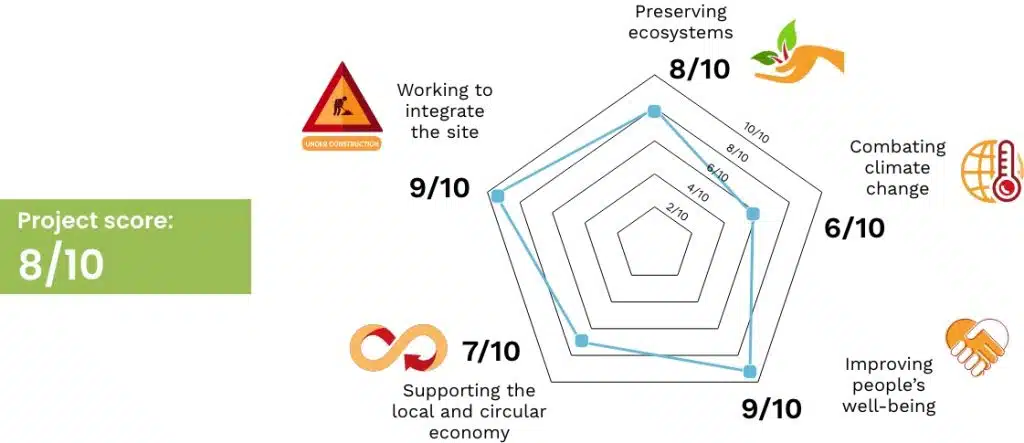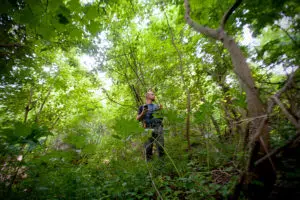Assess the environmental and social footprint and performance of our projects.
As a player in the local circular economy designed to improve urban metabolism, ECT attaches particular importance to assessing the footprint of its non-built development projects, carried out using soil from construction sites.
To this end, ECT has developed a composite indicator for assessing environmental and societal impacts, each of which gives rise to a specific assessment. All these data are aggregated and consolidated according to the project’s type of use.
The assessment methodology was developed with the involvement of all the company’s departments and the assistance of experts (sociologist, ecologist, farmer, acoustician, etc.), in order to guarantee a high level of method robustness.
Expertise associated with ECT's IQES methodology
Our quality indicators
environmental and social aspects of projects
15 indicators have been developed to address two types of challenge identified by ECT: improving the well-being of users before and after the works, and participating in the social economy.
Within this framework, the indicators cover a wide range of ESG issues and respond to both social and environmental challenges:
Environmental issues
The four indicators developed by ECT address two major challenges: preserving ecosystems and combating climate change. In this way, they measure the environmental contribution of ECT projects.
Preserving ecosystems
Surface biodiversity
It measures habitat functionality, coherence with the surrounding environment and contribution to the ecological functionality of the site’s surroundings. If a 4-season study is carried out, it assesses the protection of endangered species on the site.
Infiltration and water retention
It compares the soil’s capacity to infiltrate stormwater before and after land development, and assesses the need for additional water and flood management equipment.
Fight
against climate change
Measuring greenhouse gas emissions and carbon sequestration
It measures the quantities of GHG emitted / quantity of soil reused on site (or received), as well as the difference in sequestration between the initial state and the final state.
Creating islands of freshness
It assesses the site’s contribution to the cooling of surrounding urban areas through albedo, permeability and ground vegetation cover.
Creation of a freely evolving natural wetland environment on the ECT site at Roissy-en-Brie (77)
Gil Fornet
Social issues
Improve
people's well-being
Creation of green spaces
It promotes ECT projects that increase the ratio of green space. A green space is a space with plants in the ground, with the exception of agricultural spaces.
Leisure facilities
It assesses the number of facilities per individual, the quality of these facilities and the accessibility and complementarity of the offer in relation to that of the municipality.
Landscape integration
It analyzes the site’s integration into its immediate surroundings and the wider landscape, the diversity of planting and the work carried out on the site’s external boundaries.
Support
local and circular economy
Local job creation
It measures the number of jobs created for the operation and development of ECT sites, as well as the external jobs required to manage the development once it has been completed.
Preserving local agriculture
It assesses the project’s contribution to the increase in agricultural land and the eco-compatible or non-compatible production methods implemented.
Circular reuse of excavated soil
It measures the volume of reclaimed soil per unit area of the site, and the site’s maximum soil capacity in absolute terms.
Renewable energy production
Where applicable, it analyzes the site’s installed renewable energy production capacity (photovoltaic, wind, methane) and its contribution to local energy needs.

Acting to integrate the site
in its environment
Sound quality
It assesses the risk of noise pollution linked to on-site activity (truck arrivals and departures, machine operation) and ECT’s response by adapting the phasing and backfilling zones.
Impact on roads
It measures the impact of heavy goods vehicle (HGV) traffic generated by ECT’s activity on roads that were not designed to carry such traffic, and takes into account the measures taken by ECT to improve road conditions (repairs, cleaning).
Site accessibility
it analyzes the accessibility of the site by truck and the associated inconvenience for local residents. it takes into account the compulsory routes created as a result of the risk analysis.
Dust management
It measures the contribution of ECT operations to local fine particle concentration.
Park and children’s playground at 3 Rivières (Stains- 93)
Gil Fornet / ECT
EVALUATION EXAMPLE
A PROJECT IN DEVELOPMENT
These 15 indicators are used operationally by ECT teams to better assess the added value and impact of each project, in order to optimize design and management choices and provide the various stakeholders with a map of the value generated.



